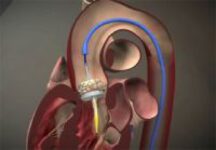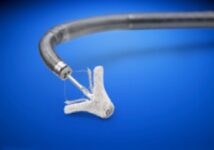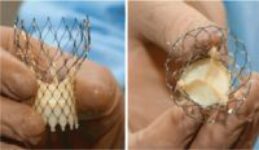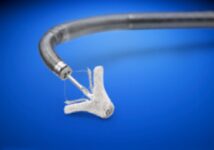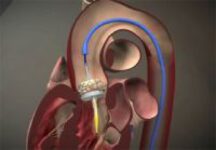Original title: Prosthetic valve endocarditis after transcatheter aortic valve implantation: the incidence in a single-centre cohort and reflections on clinical, echocardiographic and prognostic features. Reference: Miriam Puls et al. EuroIntervention 2013;8:1407-1418. Prosthetic valve endocarditis is a serious complication of surgical valve replacement and occurs in 0.3 to 1.2% of patients per year. It is basically divided in early…
Low Gradient Severe Aortic Stenosis despite Preserved Ejection Fraction
Original title: Invasive Hemodynamic Characteristics of Low Gradient Severe Aortic Stenosis Despite Preserved Ejection Fraction. Reference: Juliane Lauten et al. J Am Coll Cardiol 2013;61:1799–808. Although the pathophysiology, clinical features, and natural course of severe aortic stenosis have been extensively described, management recommendations are still evolving. The current European and American guidelines recommend a valve area cutoff of…
Post TAVI Hypertension is a predictor of better evolution
Original title: Post-Procedural Hypertension Following Transcatheter Aortic Valve Implantation Incidence and Clinical Significance. Reference: Gidon Y. Perlman et al. J Am Coll Cardiol Intv 2013. Article in press. Pre-procedural hypertension (HTN) is a risk factor and a predictor of increased mortality after surgical aortic valve replacement (AVR). The disappearance of the pressure gradient across the aortic valve following…
Coronary Obstruction after TAVI: dreaded, but rare and solvable
Original title: Coronary Obstruction After Transcatheter Aortic Valve Implantation. A Systematic Review. Reference: Henrique Barbosa Ribeiro et al. J Am Coll Cardiol Intv 2013. Article in press. In the context of Transcatheter Aortic Valve Implantation (TAVI) there can be complications such as conduction disturbances, bleeding, residual aortic insufficiency or vascular complications, all of which have been detailed with…
Valve-in-Valve Implantation Is Possible
Original title: 5 Years Experience With Trancatheter Tranaspical Mitral Valve –in Valve Implantation for Bioprosthetic Valve Dysfunction Reference: Anson Cheung et al. J Am Coll Cardiol 2013;61:1759–66. Percutaneous valves development, first aortic and now mitral, has brought an opportunity to improve life quality and extend life for high risk non-surgical patients. 23 patients received transapical implantation in mitral…
MitraClip® in real life
Original title: Acute outcomes after MitraClip® therapy in highly aged patients: results from the German TRAnscatheter Mitral valve Interventions (TRAMI) Registry. Reference: Wolfgang Schillinger et al. EuroIntervention 2013; 8-online publish-ahead-of-print April 2013. Recently, percutaneous repair of the mitral valve with MitraClip®, (Abbott Vascular, Santa Clara, CA, USA), has emerged as an option for patients with severe mitral regurgitation,…
The need for pacemaker post TAVI does not change the prognosis
Original title: Impact of Permanent Pacemaker Implantation on Clinical Outcome Among Patients Undergoing Transcatheter Aortic Valve Implantation. Reference: Lutz Buellesfeld et al. J Am Coll Cardiol 2012;60:493–501 Although pacemaker implantation after a percutaneous aortic valve (TAVI) implantation, constitutes a significant proportion of the complications related to the procedure, this is generally considered a benign event. This study analyzed…
CoreValve versus Edwards. Equivalent results at one year
Original title: Transcatheter Aortic Valve Implantation With the Edwards SAPIEN Versus the Medtronic CoreValve Revalving System Devices. A Multicenter Collaborative Study: The PRAGMATIC Plus Initiative (Pooled-RotterdAm-Milano-Toulouse In Collaboration). Reference: Alaide Chieffo et al. J Am Coll Cardiol 2013;61:830–6. Since the introduction of percutaneous aortic valve replacement (TAVR), two devices have been widely used. For one side, the self-expanding…
Severe Mitral Insufficiency Following Mitral Valvotomy
Original title: Acute Severe Mitral Regurgitation Following Balloon Mitral Valvulotomy: Echocardiographic Feature, Operative Finfing and Outcome in 50 Surgical Cases. Reference: Manjunath C. Nanjappa, et al. Catherization and Cardiovascular Intervention 81:603-608 (2013) Severe Mitral Insufficiency Following Mitral Valvotomy (VPM) is a major complication; though not frequent, (0.9%-2%) it is life threatening and requires resolution through valve replacement. The…
Mitraclip® year results
Original title: Residual Mitral Valve Regurgitation After Percutaneous Mitral Valve Repair with Mitraclip® System in a Risk Factor of Adverse one-Year Outcome Reference: Liliya Paranskaya et al. Catheterization and Cardiovascular Intervention 81:609-617 (2013). Currently, the gold standard for the treatment of mitral regurgitation (MR) is surgery but 20% of patients are rejected because they present a high surgical…
TAVI also for pure aortic insufficiency
Original title: Transcatheter Aortic Valve Implantation for Pure Severe Native Aortic Valve Regurgitation. Reference: David A. Roy et al. J Am Coll Cardiol 2013. Article in press. Percutaneous aortic valve replacement (TAVI) has become a standard treatment for patients with severe aortic stenosis and a high surgical risk. However for those patients who have pure aortic insufficiency, (failure…



